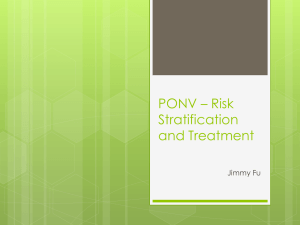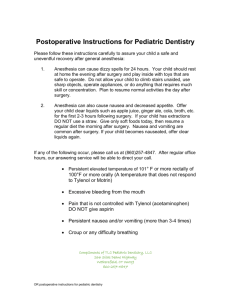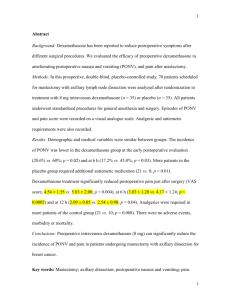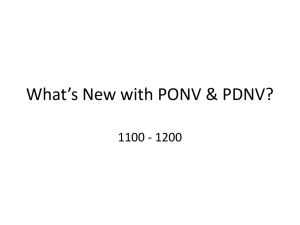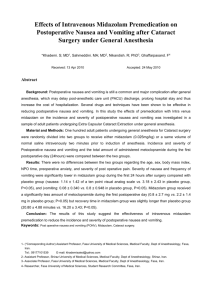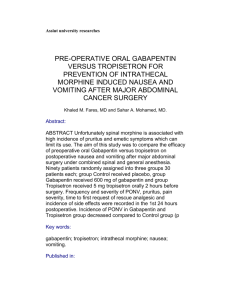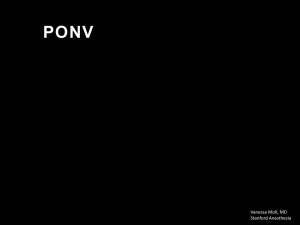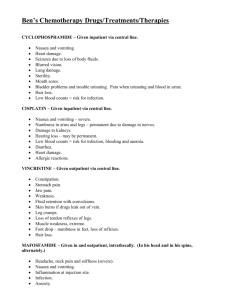Does acustimulation reduce the occurrence of post
advertisement
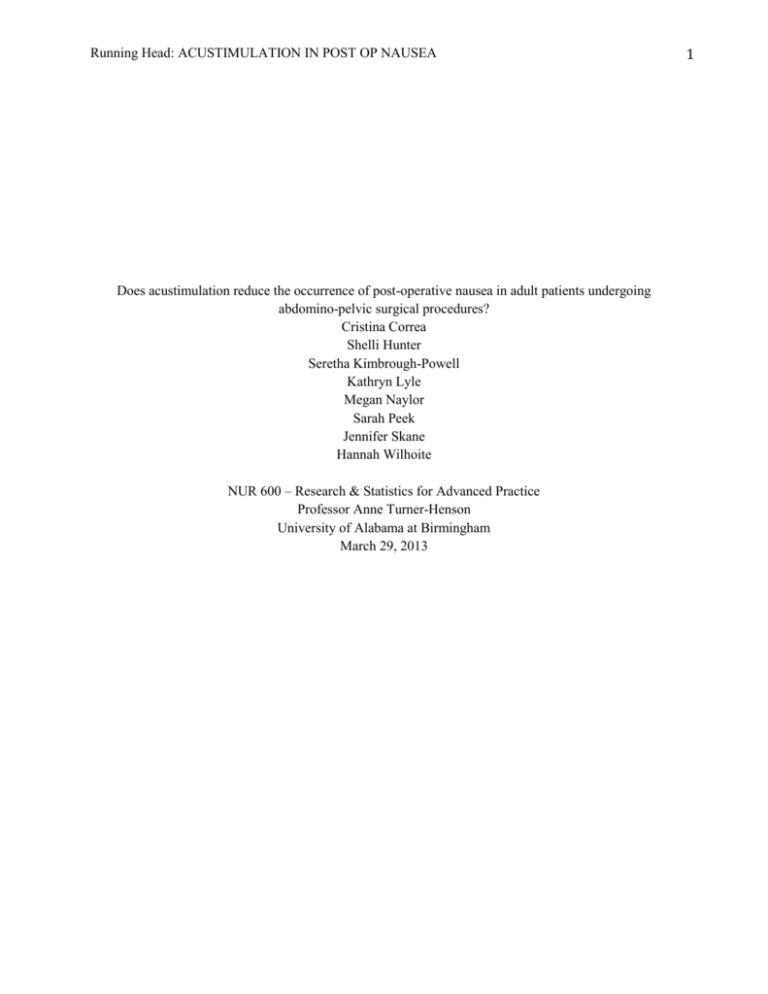
Running Head: ACUSTIMULATION IN POST OP NAUSEA Does acustimulation reduce the occurrence of post-operative nausea in adult patients undergoing abdomino-pelvic surgical procedures? Cristina Correa Shelli Hunter Seretha Kimbrough-Powell Kathryn Lyle Megan Naylor Sarah Peek Jennifer Skane Hannah Wilhoite NUR 600 – Research & Statistics for Advanced Practice Professor Anne Turner-Henson University of Alabama at Birmingham March 29, 2013 1 ACUSTIMULATION IN POST OP NAUSEA 2 Introduction Post-operative nausea and vomiting (PONV) is an adverse event often experienced post anesthesia. According to the American Society of PeriAnesthesia Nurses Clinical Practice Guideline, PONV is the most commonly occurring postoperative complication, affecting seventy-five million people annually (2013). PONV results in unnecessary patient discomfort, prolonged post-operative stays, increased healthcare costs, inhibition of the healing process, and an overall negative surgical experience. In current practice, various anti-emetic medications are utilized to control PONV. Acustimulation has recently been integrated as a non-pharmacologic approach to PONV control. This new approach is being investigated to determine its effectiveness in the reduction of PONV. The independent variable being researched is the use of P6 acustimulation, and the dependent variable is the effect on PONV. Appraisal of Collective Findings The collective findings of six randomized controlled trials examined the effects of acustimulation on post-operative patients in the reduction of nausea and vomiting. Five articles focused on women ages 18-81 undergoing elective gynecological and abdominal laparoscopic surgery. One article focused on males and females older than 18 years undergoing laparoscopic cholecystectomy. All six articles found a decrease in PONV with P6 acustimulation. Two studies, Frey, Funk, Lohlein, & Peters (2009) and Frey, Scharmann, Lohlein, & Peters (2009), found that the timing of pre- or post-induction of anesthesia had no significant effects on PONV reduction. However, El-Deeb & Ahmady (2011) explained that acupuncture should be performed prior to emetic stimulation by anesthesia and surgery. Four articles addressing acustimulation prior to anesthesia found that PONV was decreased up to six hours post-operatively, with no decrease in PONV 24 hours post-operatively, while the study of Frey and Scharmann (2009) did find reduced effects of late PONV (24 hours). Only one study by Turgut et al. (2006) evaluated PONV in gynecological patients receiving Morphine through PCA pumps. Frey & Scharmann (2009) and Frey & Funk (2009) both used the ReliefBand as an instrument in their studies, applying 31Hz. The study of Kim, Kim, Lee, Shim, & Yoon (2011) found the largest decrease in PONV through the use of a Cleartrode instrument at 50Hz showing a success of 49% in the treatment group, which included a ACUSTIMULATION IN POST OP NAUSEA decrease by 48% in nausea and 59% in vomiting. While all six research studies resulted in improvement of PONV, some also resulted in an overall improvement of satisfaction scores as well. The strength of acustimulation is being a low-risk, non-invasive, affordable option to implement within a 6 hour postoperative period resulting in reduced PONV. The weakness of ascustimulation is that not everyone is a candidate and evidence does not conclude that it reduces PONV after the 6 hour post-operative period. Decision Based on Evidence in Nursing Practice The use of acupressure stimulation would be a cost-effective, non-pharmacologic and noninvasive intervention to implement in the treatment of gynecologic patients who are at risk for PONV. Studies have shown that this intervention has been effective specifically in gynecologic laparoscopic surgeries. In another study that included both males and females undergoing laparoscopic cholecystectomy, it was found that PONV within the first two hours after surgery was significantly lower in the group who received acustimulation (Frey and Funk, 2009). Based on this evidence, there appears to be a beneficial relationship between the use of acupressure stimulation and laparoscopic surgeries. Thus the evidence presented in the research supports an addition of acupressure stimulation therapy to current practice for the control of PONV. Implications for Practice Through the use of electrical acustimulation, patients can experience a decrease in PONV as opposed to using anti-emetic therapy alone. Acupressure stimulation has been found to be effective against nausea in the early post-op stages, specifically in the first 6 hours after surgery (Arnberger, et al., 2007). Acustimulation has also been effective in decreasing nausea and vomiting in patients with Morphine PCA pumps after surgery (Turgut, et al., 2006). Various techniques including the use of a Seaband, electrodes, and a ReliefBand were used to apply the acupressure stimulation, which allows for variation in applying the intervention. Studies have shown the combined use of early acustimulation and anti-emetic drug therapy can further decrease PONV in laparoscopic patients. Further research will be necessary to determine the effectiveness of acupressure stimulation in patient populations outside of those undergoing laparoscopic surgeries. ACUSTIMULATION IN POST OP NAUSEA 4 References American Society of PeriAnesthesia Nurses. (2013). PONV/PDNV Clinical Guidelines. Retrieved from: http://www.aspan.org/ClinicalPractice/ClinicalGuidelines/PONVPDNV/tabid/3257/Default.aspx Arnberger, M., Stadelmann, K., Alischer, P., Ponert, R., Melber, A., & Greif, R. (2007). Monitoring of Neuromuscular Blockade at the P6 acupuncture point reduces the incidence of postoperative nausea and vomiting. Anesthesiology, 107(6), 903-908. doi: 10.1097/01.anes.0000290617.98058.d9 Level: Randomized control trial Strength of research evidence: Strong El-Deeb, A. M., & Ahmady, M.S. (2011). Effect of acupuncture on nausea and/or vomiting during and after cesarean section in comparison with ondansetron. Journal of Anesthesia, 25(5), 698-703. doi: 10.1007/s00540-011-1198-0 Level: Randomized control trial Strength of research evidence: Strong Frey, U. H., Funk, M. M., Lohlein, C. C., & Peters, J. J. (2009). Effect of P6 acustimulation on post-operative nausea and vomiting in patients undergoing a laparoscopic cholecystectomy. Acta Anaesthesiologica Scandinavica, 53(10), 1341-1347. doi:10.1111/j.13996576.2009.02081.x Level: Randomized control trial Strength of research evidence: Strong Frey, U., Scharmann, P., Lohlein, C., & Peters, J. (2009). P6 acustimulation effectively decreases postoperative nausea and vomiting in high-risk patients. British Journal of Anaesthesia, 102(5), 620-625. doi: 10.1093/bja/aep014 Level: Randomized control trial Strength of research evidence: Strong ACUSTIMULATION IN POST OP NAUSEA Kim, Y. H., Kim, K. S., Lee, H. J., Shim, J. C., & Yoon, S. W. (2011). The efficacy of several neuromuscular monitoring modes at the P6 acupuncture point in preventing postoperative nausea and vomiting. Anesthesia and Analgesia, 112(4), 819-823. doi: 10.1213/ANE.0b013e31820f819e Level: Randomized control trial Strength of research evidence: Strong Turgut, S., Ozalp, G., Dikman, S., Savli, S., Tuncel, N., & Kadiogullari, N. (2007). Acupressure for postoperative nausea and vomiting in gynaecological patients receiving patient-controlled analgesia. European Journal of Anaesthesiology, 24(1), 87-91. doi: 10.1017/S0265021506001190 Level: Randomized control trial Strength of research evidence: Strong ACUSTIMULATION IN POST OP NAUSEA 6 N600 Collective Findings Table Category Reference (.91 points/ .15 each article) This article was chosen because of the specific sample population used in the study as well as the randomized controlled trial utilized. Kim, Y. H., Kim, K. S., Lee, H. J., Shim, J. C., & Yoon, S. W. (2011). The efficacy of several neuromuscular monitoring modes at the P6 acupuncture point in preventing postoperative nausea and vomiting. Anesthesia and Analgesia, 112(4), 819-823. doi: 10.1213/ANE.0b013e31820f819e Purpose (.91 points) Sample (.91 points) Conceptual or Theoretical Framework (.91 points) Concepts and Variables (.91 points) Design (.91 points) This study sought to find the most effective neuromuscular monitoring mode in post-operative nausea and vomiting (PONV) by comparing multiple neuromuscular monitoring modes: single twitch (ST), train-of-four (TOF), double-burst stimulation (DBS), and tetanus at the P6 acupuncture point and identify which mode can best prevent PONV after patients receiving laparoscopic hysterectomy surgery. Multiple neuromuscular interventions have been studied in decreasing PONV. A power analysis of PONV from a previous study determined the sample size of 50 patients per test group. The study was given IRB approval. Informed consent was obtained from 264 women, with ASA physical status I–II, between ages 31 and 67 scheduled for laparoscopic hysterectomy prior to being randomly assigned to one of five groups: Control (54 members), ST (52 members), TOF (53 members), DBS (53 members), or tetanus (52 members). Exclusion criteria was receiving antiemetic medications 24 hours or less prior to surgery, obesity, neuromuscular, hepatic, or renal diseases; or allergies to any of the medications used during the study. Theoretical Framework: Up to 70% of patients receiving major gynecologic surgery report PONV, and even higher percentage when receiving opiates post operatively. Multiple drugs as well as non-pharmacologic methods are used to help decrease PONV with minimal side effects. Several studies report the effective use of electrical stimulation of peripheral nerves at P6 acupoint against PONV. Four effective neuromuscular monitoring modes were chosen for comparison in this study in order to find the most effective intervention for PONV and accurately measuring neuromuscular blockade. Independent variables consisted of single twitch (ST), train-of-four (TOF), doubleburst stimulation (DBS), and tetanus neuromuscular monitoring modes at the P6 acupuncture point. Dependent variables consisted of nausea, vomiting and retching symptoms postoperatively. Prospective, randomized, double blind, placebo controlled study was used that included five neuromuscular monitor test groups. PONV was assessed by an independent observer unaware of the study groupings and neuromuscular monitoring mode. In the control group, two electrodes were positioned over the ulnar nerve of patient’s dominant arm prior to anesthesia and detached after anesthesia in the operating room (OR). Each electrode was attached to a peripheral nerve stimulator. In the 4 treatment groups the same electrodes, peripheral nerve stimulator, square wave pulses, constant current, as the control group were used prior to anesthesia and removed after anesthesia in the OR, but placed on the median nerve at the P6 acupoint on the patient’s dominant arm and tested using the different monitoring modes respectively. ACUSTIMULATION IN POST OP NAUSEA Instruments/How variables measured (.91 points) Interventions/or methods (.91 points) Statistical Tests/ Analysis Method (.91 points) Results/Findings (.91 points) Implications (.91 points) An investigator uninvolved with the members of the study set up the neuromuscular monitors. Both patients and medical staff were unaware of group assignments. A simplified Apfel score was used to measure PONV risk on a 3 point scale: 0-no symptoms, 1-only nausea, 2-vomiting. The highest score was documented for study purposes. Pain scores were measured using a scale: 0=no pain to 10=unbearable pain. The first 24 hours after surgery use of opioids and patient satisfaction scores were documented (0=very dissatisfied to 10=most satisfied). ST, TOF, DBS, and tetanus neuromuscular monitoring modes at the P6 acupuncture point were used as interventions in comparison to a control group and each other. No training was involved in preparing the subjects for the study. Differences between the five groups were shown using a series of 1-way analysis of variances. The post hoc Bonferroni correction test was used for comparisons if a significant difference was found. The Kruskal-Wallis test and the Mann-Whitney rank sum test were used to measure differences in nonparametric group variables and intergroup differences. Analysis of variance for repeated measures was used to assess pain. SPSS version 17.0 statistical software was used for statistical analysis. Study groups did not reveal significantly different pain scores within the first 2 hours post op. Within 6 hours the tetanus group (P=0.003) had a significantly lesser need for opioids than the control group, but not in the ST (P=0.506), TOF (P=0.854) or DBS (P=0.273) groups. A 30% total reduction of PONV, = 0.05 and = 0.2 with a power of 80%. Statistical differences were considered significant if P < 0.5. This study revealed 70% of patients reported PONV in the control group (P=0.022), compared to 49% in the treatment groups. The tetanus group also revealed higher overall satisfaction scores in comparison to the control group. There were no differences found in the ST, TOF, and DBS groups compared with the control group. The effect of electroacupuncture on PONV is unknown at this time. Limitations to the study include continuous use of patient controlled anesthesia, and the use of a non-verbal pain scale. P6 tetanic acupuncture has been found to reduce PONV mostly within the first 6 hours after laparoscopic hysterectomy surgery while also proving to increase patient satisfaction. Because of the minimal side effects seen after use of acupuncture, the integration of the practice is realistic with further research. ACUSTIMULATION IN POST OP NAUSEA 8 N600 Collective Findings Table Category Reference (.91 points/ .15 each article) This article was chosen provided the article’s study included the specific population requirements. The study was randomized and controlled. El-Deeb, A. M., & Ahmady, M. S. (2011). Effect of acupuncture on nausea and/or vomiting during and after cesarean section in comparison with ondansetron. Journal of Anesthesia, 25(5), 698-703. doi: 10.1007/s00540-011-1198-0 Purpose (.91 points) Sample (.91 points) Conceptual or Theoretical Framework (.91 points) Concepts and Variables (.91 points) Design (.91 points) Instruments/How variables measured (.91 points) Interventions/or methods (.91 points) The purpose of this study was to compare the effects of electrical acustimulation via acupuncture therapy to the P6 acupoint (pericardium 6) with ondansetron medication therapy for treatment and prevention of intraoperative and postoperative nausea and vomiting (PONV). Both acupuncture and ondansetron have both been used to decrease PONV for a number of reasons. This study compared the two interventions in PONV. 450 women that met ASA physical status I-II were scheduled for an elective cesarean section delivery utilizing spinal anesthesia, between the ages of 25 and 35 years of age. A sample size of 137 was used for each group. Each group comprised 150 subjects; extra patients were included to avoid defaulters Each participant signed informed consent and the study granted IRB approval. Exclusion criteria included any acupuncture treatments within 6 months, nausea or vomiting within a 24hour time window prior to operation, diabetes, hypertension, cardiovascular disease, or other systemic disease. Participants were placed into one of three groups using randomized sealed envelope assignments. Each group contained 150 participants. 1control group, 2- the ondansetron group, 3, the electro-acupuncture group. Theoretical Framework: Complications of general anesthesia include PONV. No therapy has proven effective for completely eliminating PONV. Limited availability and side effects of available antiemetic medicines has encouraged further interventions for PONV. Decreasing PONV is one of many studied effects of acupuncture. Ondansetron was chosen for this study due to economic reasons and unlikelihood of manifestation of extrapyramidal symptoms in comparison to other antiemetic drugs. Independent variables consisted of ondansetron and electro-acupuncture. Dependent variables consisted of intra and postoperative nausea and vomiting, and overall patient satisfaction. This was a randomized, double blind study that included three separate test groups. Nausea, vomiting, and patient satisfaction were measured throughout the study. An independent anesthetist who was blinded to group assignment evaluated PONV every 10 min intra-operatively and at 2, 4, 6, 12, and 24 hours after surgery. An analogue score was used to assess nausea (0, no nausea; 10, worst nausea) ondansetron 4 mg IV was given for a score of 4 or worse, or active vomiting. The time to first emetic event, the duration of surgery, amount of ephedrine consumed, and other complications were documented. Patient satisfaction scores were based upon the entirety of the patient experience (satisfied or not satisfied). Ondansetron and electro-acupuncture were both used as interventions in comparison to a control group and each other. Each participant received 1liter Lactated Ringers solution. The ondansetron group received 4mg IV ondansetron and false acupuncture treatments. The acupuncture group received P6 acupoint stimulation and false IV drug injection. The control group received false acupuncture and drug injection. No ACUSTIMULATION IN POST OP NAUSEA Statistical Tests/ Analysis Method (.91 points) Results/Findings (.91 points) Implications (.91 points) training was involved in preparing the subjects for the study. This study used an appropriate type of sample by using the Epicalc program 2000 with a power of 80% and confidence interval of 95%. The Kolmogorov–Smirnov test was used for analysis of data distribution normality. One way Analysis of Variance and least significant difference tests were used to test the data for statistical significant differences between groups and intergroup comparisons. Quantitative data between groups was compared with the student’s t test. Qualitative data was tested using the chi square test. A significant P was measured at <0.05 with a 95% confidence interval. Prophylactic P6 acupuncture proved a reduction of PONV by 25% in more than half of the participants in the control group, and prophylactic ondansetron proved a reduction of PONV by 35%. Treatments in groups 2 and 3 intra-operatively and for 6 hours post operatively proved less NV during the study time frame P = 0.001 and 0.003 respectively. Patient satisfaction scores increased in both groups 2 and 3 in comparison to the control group 1. The study established the positive effects of improving patient satisfaction with decreased intraoperative, and early PONV with the use of electro-acustimulation. Members in the control group reported PONV of 34% immediately after surgery, 28% reported NV 6 hours post op which reduced to 9% in group 2, and 7% in group 3. The time period to first PONV symptoms was considerably less in groups 2 and 3 compared to the control. Changes proved to be statistically significant and imply a comparable effectiveness of both interventions. There was no significant change in any of the groups PONV at 24 hours. Comparable to ondansetron post op, Electro-acustimulation is an affordable and relatively simple option in prevention of PONV. Further studies are necessary for efficacy and safety of both electrical acustimulation plus Ondansetron as prophylaxis treatment of NV during and after cesarean deliveries. ACUSTIMULATION IN POST OP NAUSEA 10 N600 - Collective Findings Table Category Reference (.91 points/ .15 each) This article was chosen because it met requirements of assignment being a random control trial published within the last 10 years. It also met our population of an adult sample of women undergoing a surgical procedure. Arnberger, M., Stadelman, K., Alischer, P., Ponert, R., Melber, A., & Greif, R. (2007). Monitoring of neuromuscular blockade at the P6 acupuncture point reduces the incidence of postoperative nausea and vomiting. Anesthesiology, 107(6), 903-908. doi: 10.1097/01.anes.0000290617.98058.d9 Purpose (.91 points) Sample (.91 points) Conceptual or Theoretical Framework (.91 points) Concepts and Variables (.91 points) Design (.91 points) Instruments/ How variables measured (.91 points) “To evaluate the effects of electrical stimulation of the P6 acupuncture point at the dominant wrist using a conventional neuromuscular stimulation device for the evaluation of muscle relaxation during general anesthesia on the incidence of postoperative nausea and vomiting (PONV) on women undergoing gynecological surgery.” (Amberger, Stadelman, Alischer, Ponert, Melber, & Grief, 2007) The hypothesis was to test that stimulation of the P6 acupuncture point with a conventional nerve stimulator decreases the incidence of PONV. Sample size calculation was based on the PONV incidence from a previous study by authors where the control group of PONV was 44% and treatment group reduction by 50%. IRB approval and informed consent was obtained from 220 women ages 18-80 that met ASA physical status I-III scheduled to undergo elective gynecological and abdominal laparoscopic surgery of more than 1 hour duration to participate in the study. Patients were randomly selected to either a control or treatment group by computergenerated numbers resulting in 110 participants in each. Subjects and evaluators were unaware of group assignment. Exclusion criteria: current pregnancy/breastfeeding, eating disorders, obesity, severe renal and/or liver malfunction, CNS injury, vertebrobasilar artery insufficiency, vestibular disease, cytostatic therapy, and preoperative vomiting or antiemetic therapy. There were no dropouts during observation. Theoretical Framework: Monitoring of neuromuscular blockade is standard during anesthesia. The idea for the study was triggered by the theory, based on review of similar successful studies, that a constant electrical stimulus over the median nerve at the P6 point might have an advantageous effect on PONV while monitoring neuromuscular blockade simultaneously. IV: intraoperative transcutaneous electrical stimulation of the P6 acupuncture point with nerve stimulator DV: postoperative nausea and vomiting The study was a prospective, double-blinded, random control trial. Candidates were randomized into two groups, control or treatment. Measurements included pain, nausea and vomiting within certain blocks of time in a 24-hour period and need for rescue medication as well as monitoring for side effects of treatment. Data collected preoperatively from records and personal interviews. Preoperative and postoperative data was averaged for each group. Ondansetron was used as an antiemetic rescue medication and post-op analgesics were monitored and recorded for 24 hours. Pain was evaluated with a continuous visual analog scale (1=0 pain to 10= unbearable pain). Patients were evaluated for side effects of nerve stimulation and for nausea and vomiting at the following intervals while awake: 0-2 hours, 2-6 hours (early PONV), 6- ACUSTIMULATION IN POST OP NAUSEA Interventions or methods (.91 points) Statistical Tests/ Analysis Method (.91 points) Results/ Findings (.91 points) Implications (.91 points) 12 hours, 12-24 hours (late PONV). Nausea was defined as the desire to vomit, vomiting as active expulsion of gastric contents, retching as active attempt to vomit without expulsion. To address validity, patients and PONV evaluators were uninformed of group assignments. The attending anesthesiologist was not involved in the assessment as he could not be blinded to group assignment. Authors assessed dominant hand during interview process as is recommended. Both randomly selected groups given same medications for anesthesia and reversal and the same amount of neuromuscular stimulation. Control: ulnaris group-subjects had electrode placed on ulnar nerve and on radial side of wrist to elicit thumb adduction with stimulation Treatment : P6 acupuncture group-electrode were used to stimulate the medial nerve at P6 point of the forearm by placing electrodes proximal and distal to P6 point so the current would mass through. The previous study determined a sample size of 216 would provide 95% chance of statistical significance between groups at a two-tailed -level of 0.05 (type I error) using a chi-square analysis. Chi-square testing used for Morphometric and parametric data as well as intraoperative and postoperative results were compared for interval data with a Student t test or for categorical data, analysis of number of patients with PONV in each group for 24 hours. Statistical significance at P< 0.05, data presented as mean +/- SD or as percentages. Statistical analysis was conducted using SAS 9.1 and Primer of biostatistics. No dropouts reported in either group (n=110 each). No side effects reported or detected. Results for pain at 2-hour mark (2.1 +/- 1.7 for P6 vs. 1.9 +/- 1.5 for control, P=0.41). Need for opioids within 6 hours. (6 +/- 6vs. 5 +/- 5mg, P=0.14) and late, up to 24 hours (1 +/- 5 vs. 1 +/- 2mg, P=0.19). No significant difference in NSAIDS use for 24 hours (55% vs. 68%, P=0.051). Postoperative nausea was significantly lower in P6 treatment group (40% vs. 56%, P=0.022). Early combined PONV and nausea at 0-6 hours (33% vs. 51%, P=0.009) where no difference found in late period. Decrease of 12% found in need for rescue antiemetic (27% vs. 39%, P=0.086) in 24 hours with major difference early phase (25% vs. 36%, P=0.109), and no difference in late period. Combined unilateral stimulation of P6 acupressure point while measuring neuromuscular blockade reduces PONV overall in the early period after surgery. Combination acustimulation and medication for prophylactic use in surgery is promising and most effective in early nausea (first 6 hours). The effects were similar to antiemetic medication. It’s cost effective and easy to perform with no side effects or complications. Limitations included female only subjects, use of single-twitch mode as opposed to train-of-four mode of neuromuscular blockade, and lack of a formal cost-effective analysis. More testing would be needed in the future was well as application to other settings and subjects. ACUSTIMULATION IN POST OP NAUSEA 12 N600 Collective Findings Table Category This article was chosen because it is a peer reviewed randomized controlled trial less than 10 years old (published in 2006). It provided insight into use of P6 acustimulation in our target population, female gynecological patients. Reference Turgut, S., Ozalp, G., Dikmen, S., Salvi, S., Tuncel, G., & Kadiogullari, N. (2006). Acupressure for postoperative nausea and vomiting in gynaecological patients receiving patient-controlled analgesia. European Journal of Anaesthesiology, 24(1), 87-91. doi: 10.1017/S0265021506001190 Purpose Sample “To evaluate the effectiveness of acupressure in preventing nausea and vomiting in patients undergoing gynaecological operations and receiving a patient-controlled analgesia device” (Turgut, Ozalp, Dikmen, Salvi, Tuncel, Kagiogullari, 2006). Probability sampling was used in this study. 100 female patient’s ages 40-65 years old with an ASA level I-II undergoing elective gynaecological surgery were randomized into two groups, acupressure group and control group using closed envelopes. Exclusion criteria included obesity (BMI > 30), diabetes mellitus, and history of motion sickness, postoperative nausea/vomiting, or smoking. The study was observer-blinded and the participants had no previous experience with acupressure bands. Conceptual or Theoretical Framework Theoretical framework: Acupressure at the P6 meridian point will lead to a decrease in experienced postoperative nausea and vomiting. Prevention of nausea increases patient satisfaction. Stimulation of the P6 meridian point is non-pharmacological and non-invasive. Concepts and Variables Independent variable: P6 stimulation Dependent variable: Postoperative nausea and vomiting Design Experimental design was used for this study. There were two groups: intervention group (receiving P6 stimulation, n=50) and the control group (no P6 stimulation, n=50). Five different outcomes were measured: sedation, postoperative nausea, vomiting, pain, and patient satisfaction. Instruments/How variables measured Sedation was measured with a five-point scale (1: completely awake, 2: awake but drowsy, 3: asleep but responds to verbal commands, 4: asleep but responds only to physical stimulus, 5: unarousable). Postoperative nausea was defined as none, mild, moderate, or severe Degree of vomiting was recorded as none, mild (1-2 episodes), moderate (3-5), and severe (>5) Visual analog scale (VAS) was used to determine pain level Patient satisfaction was assessed using a 4-point scale (1: poor, 2: moderate, 3: good, ACUSTIMULATION IN POST OP NAUSEA 4: excellent) Interventions/or methods The intervention used was acupressure (using a plastic bead) of the P6 point using a SeaBand. The control group had the SeaBand placed with the plastic bead at a site other than the P6 point. The researchers discussed the proper positioning of the SeaBand in the study, on the anterior forearm between the tendons of the extensor carpi radialis and the palmaris longus. In both groups, bands were covered by loose gauze to ensure observer-blinding. The acupressure bands were applied 30 minutes before induction of anaesthesia in both groups. The anesthesiologist who placed the bands was not involved in the outcome assessments. In addition, the patients did not receive any antiemetic medication before or during surgery. Statistical Tests/ Analysis Method Age, weight, height, operation time, HR, arterial pressure, respiratory rate and total morphine consumption were compared using the T-test. Chi-squared test was used to analyze nausea, vomiting, additional analgesic consumption, ASA classification and antiemetic requirement. VAS, sedation and patient satisfaction by U-test Results/Findings Implications With acupressure, the incidence of nausea and vomiting were 33% and 25%, respectively, and in controls was 63% and 61%. The study showed acupressure of the P6 point decreased nausea and vomiting effectively in postoperative patients receiving Morphine PCA. "The cumulative incidence of nausea, vomiting, and antiemetic use was significantly lower with acupressure (P< 0.05)" (Turgut et al., 2006). In patients with a moderate baseline risk of nausea and vomiting postoperatively P6 stimulation may be used as an alternative to antiemetics. Further research is needed for patients at very high risk of postoperative nausea and vomiting. ACUSTIMULATION IN POST OP NAUSEA 14 N600 Collective Findings Table Category (points for category across all studies) Reference (.91 points/ .15 each article) Patient safety, cost effectiveness, and improved outcomes are high priority in the healthcare setting today. Forward thinking is actively seeking noninvasive, safe, nonpharmacological solutions to common problems such as PONV. P6 acustimulation is new, fresh, innovative and meets all aforementioned criteria. It is well worth the effort and resources toward research and possible implementation into practice. Frey, U. H., Funk, M., Lohlein, C., & Peters, J. (2009). Effect of P6 acustimulation on post-operative nausea and vomiting (PONV) in patients undergoing a laparoscopic cholecystectomy. Acta Anaesthesiologica Scandinavica, 53(10), 1341-1347. doi:10.1111/j.1399-6576.2009.02081.x Purpose (.91 points) To investigate the effectiveness of acustimulation on mitigating PONV in patients undergoing laparoscopic cholecystectomy (lap chole); To investigate if there are differences in PONV reduction if applied pre- or post-anesthesia induction; To investigate if PONV can be reduced independent of known risk factors (female gender, non-smoker, history of PONV/motion sickness, post op morphine usage) utilizing P6 acustimulation. Sample Calculation based upon PONV incidence within the first 6 hours after surgery and previous study. Sample size includes 200 adults, male and female, >18 years with an ASA class I-III scheduled to undergo a lap chole requiring general anesthesia. Exclusions: Those with cardiac pacemakers, implanted cardioverter/defibrillator; risk for malignant hyperthermia; allergy to nickel/chrome; changes in surgical technique. Random assignment to four different groups by drawing a sealed envelope. (.91 points) Active ReliefBand placed at the P6 acupoint of the accustimulation group (n=101): (A) pre-induction (n=57); (B) post-induction (n=44). Inactive device applied to the P6 acupoint of the Sham group (n=99): (C) pre-induction (n=55); (D) post-induction (n=44) Conceptual or Theoretical Framework (.91 points) Theoretical - PONV is the most frequent side effect of anesthesia and effectively treated pharmacologically with adverse effects. However, studies are underway to discover non-pharmacological options for PONV namely P6 acustimulation proven to reduce PONV in female patients undergoing vaginal hysterectomy with the highest incidences of reduction in patients at high risk for PONV. Also being explored is whether the placement of P6 acustimulation, pre- or post-operatively, has a significant effect on PONV. Concepts and Variables (.91 points) Design (.91 points) IV: P6 acustimulation with ReliefBand active or inactive DV: post-op nausea, retching, vomiting Single centre, prospective, randomized, double blind experimental study assessing nausea, retching, and vomiting post-op. Written informed consent obtained prior to study. Male and female patients scheduled to undergo a lap chole under general anesthesia randomly assigned to one of four groups: ACUSTIMULATION IN POST OP NAUSEA (a) Acustimulation starting before induction of anesthesia (n=57); (b) Acustimulation starting directly after induction of anesthesia (n=44); (c) Sham acustimulation starting before induction of anesthesia (n=55); (d) Sham acustimulation starting directly after induction of anesthesia (n=44) Morphometric, demographic data and risk factors collected pre-op from patient records or via interview during consent process. Data collectors blind to treatments administered. Acustimulation provided by ReliefBand (31 Hz, strength grade III of V). Two flat metal electrodes provide conduction transcutaneously; inactivity achieved by covering with silicone invisible to the patient and data collector. Active and sham bands placed in induction room to the P6 acupoint on the dominant upper extremity. Instruments/How variables measured (.91 points) Patients evaluated for nausea, retching, vomiting, pain and potential side effects of ReliefBand by an investigator blind to group assignments. Nausea, vomiting and retching categorized by: 0=no episode; 1=at least 1 episode; interval 2h in PACU; 6hour and 24 hours after surgery. Vomiting defined as expulsion of stomach contents; retching defined as involuntary attempt to vomit but no production of stomach contents. Interventions/or methods (.91 points) Active ReliefBand device placed at the P6 acupoint of the acustimulation group; Inactive device applied at the P6 acupoint of the sham group. No intervention training was provided; fidelity not specifically addressed. ReliefBand FDA approved, non-invasive Statistical Tests/ Analysis Method (.91 points) Two-sided tests, computer software SPSS, version 15.0 used for all statistical tests. Parametric variables compared using an unpaired student’s t-test; categorical variables using the X2 test. Multivariate binary logistic regression model used to calculate odds ratios (ORs); 95% confidence intervals (CI), and P-values for the risk of PONV. Logistic regression analysis performed in a stepwise backward manner using age, gender, body mass index, duration of anesthesia, post-op morphine usage, history of PONV, smoking status, history of motion sickness and acustimulation as covariates. Differences statistically significant if alpha error P of <0.05. Results/Findings (.91 points) Early nausea (up to 2h postop) was significantly lower in the acustimulation group than in the sham group (29% vs. 42%; P=0.043) but there was no significant effect on retching/vomiting. The best effects on nausea was in patients with three or more risk factors for PONV (relative risk reduction 40%; P=0.021; 55% for retching/vomiting; P=0.048). There was no effect on PONV after 6 and 24 hours. PONV was significantly lower in the acustimulation group compared with the sham group (30% vs 43%; relative risk reduction: 31%; P=0.031). The timing, pre- or post-induction, had no significant effect on PONV reduction. Implications (.91 points) P6 acustimulation is proven effective in early pre- and post-operative period for vaginal hysterectomy and lap chole patients with even higher success rates in the presence of 3 or more risk factors. Implications to practice should be based upon the results of further studies. ACUSTIMULATION IN POST OP NAUSEA 16 N600 Collective Findings Table Category Reference This article was chosen because it included information about PONV prevention in our target population. It is randomized and controlled Frey, U., Scharmann, P., Lohlein, C., Peters, J. (2009). P6 acustimulation effectively decreases postoperative nausea and vomiting in high-risk patients. British Journal of Anaesthesia, 102(5), 620-625. doi: 10.1093/bja/aep014 Purpose (.91 points) Sample (.91 points) Conceptual or Theoretical Framework (.91 points) Concepts and Variables (.91 points) Design (.91 points) Instruments/How variables measured (.91 points) Interventions/or methods “The primary purpose of this study was to investigate the effectiveness of acustimulation in relation to known risk factors for PONV. We also tested the secondary hypothesis that pre- or post-induction application of acustimulation results in differences in PONV reduction” (Frey, Scharmann, Lohlein, Peters, 2009). Probability sampling was used in this study. Ethics committee approval and informed consent were obtained from 200 women > 18 years of age with an ASA class I-III who were scheduled for a vaginal hysterectomy under general anesthesia were included in this study. Exclusion criteria were patients with a cardiac pacemaker or implanted cardioverter/defibrillator, patients at risk for malignant hyperthermia, patients with an allergy to nickel/chrome, and change in surgical technique. Patients were randomly divided into an acustimulation group (n=101) or a sham acustimulation group (n=99). Those two groups were then randomized further into a preoperative (before induction of anesthesia) acustimulation group (n=48), a postoperative (after induction of anesthesia) acustimulation group (n=53), a preoperative sham acustimulation group (n=49) and a postoperative sham acustimulation group (n=50). Randomization was achieved by drawing a sealed envelope. Theoretical framework: PONV occurs in up to 30% of unselected patients and is the most frequent side effect after anesthesia. Several studies have shown the effectiveness of P6 stimulation to reduce PONV. One study, however, showed electrical stimulation at the P6 site decreased postoperative nausea but not vomiting. Optimum timing of acustimulation is debatable. PONV reduction was measured in patients with known risk factors (female gender, non-smoker, history of PONV/motion sickness, and postoperative morphine usage) both with acupressure applied before induction of anesthesia and after. Independent variables: P6 acustimulation using the ReliefBand pre-anesthesia induction and post-anesthesia induction. Dependent variables: postoperative nausea and vomiting This study was a prospective, observer-blind, randomized controlled trial. There were four different groups: two intervention and two control groups. Nausea, retching, vomiting, and pain were evaluated at 2h in the PACU, then at 6h and 24h. The investigators responsible for collecting data were blind to the treatments administered to the participants. Patients were evaluated for the occurrence of nausea, vomiting, and retching at the following intervals: 2 hours in the PACU and at 6 and 24 hours. Nausea, vomiting, and retching were categorized (0, no episode; 1, at least one episode). Acustimulation was provided via a ReliefBand – a non-invasive, FDA approved, portable, battery powered, watch-like acustimulation device capable of providing ACUSTIMULATION IN POST OP NAUSEA (.91 points) Statistical Tests/ Analysis Method (.91 points) Results/Findings (.91 points) Implications (.91 points) current at 31 Hz up to 35 mA gradable in five strengths. The devices were applied in the anesthesia induction room to the P6 acupoint on the dominant upper extremity. The Sham ReliefBands were prepared by inactivating the electrodes with a silicone cover. No training was necessary for use of the ReliefBand. Tropisetron was used as a rescue antiemetic for any patient that experienced severe nausea or retching. Categorical variables (nausea, vomiting, and retching) were determined using the Chi-squared test. Parametric variables were analyzed using an unpaired Student’s ttest. A binary logistic regression model was used to calculate odds. Confidence intervals and P values were used for the risk of PONV or the need of rescue therapy. Differences were regarded statistically significant with an alpha error of <0.05. All statistical analyses were two-sided and performed using SPSS, version 15.0. PONV was significantly lower in the acustimulation group (33% at 6 h, 33% at 24 h) compared with the sham group (55% at 6 h, 63% at 24 h). Only 39% of patients required a rescue antiemetic in the acustimulation group, compared with 61% in the sham group. No significant difference in PONV was found between applying the ReliefBand pre- or post-induction of anesthesia (0.31 versus 0.33). Acustimulation by the ReliefBand decreases PONV, with greater effects on nausea than vomiting, in patients with three or more risk factors. Acustimulation was effective regardless of when applied (pre- or post-induction). The study was limited by a tingling sensation felt by patients receiving P6 acustimulation pre-induction which could have led to patient bias. Findings of the study were hard to generalize due to the focus on a specific surgical procedure in women receiving postoperative morphine.
